RICHARD’S CTV NEWSCHANNEL WEEKEND REVIEWS FOR FRIDAY JANUARY 3, 2025!
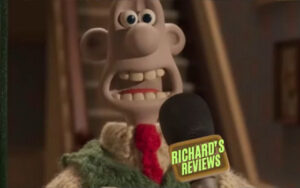 I join the CTV NewsChannel to talk about the animated “Wallace & Gromit: Vengeance Most Fowl,” the spy thriller “Harbin” and the rerelease of “Seven.”
I join the CTV NewsChannel to talk about the animated “Wallace & Gromit: Vengeance Most Fowl,” the spy thriller “Harbin” and the rerelease of “Seven.”
Watch the whole thing HERE!
 I join the CTV NewsChannel to talk about the animated “Wallace & Gromit: Vengeance Most Fowl,” the spy thriller “Harbin” and the rerelease of “Seven.”
I join the CTV NewsChannel to talk about the animated “Wallace & Gromit: Vengeance Most Fowl,” the spy thriller “Harbin” and the rerelease of “Seven.”
Watch the whole thing HERE!
 Fast reviews for busy people! Watch as I review three movies in less time than it takes to do a high five! Have a look as I race against the clock to tell you about the animated “Wallace & Gromit: Vengeance Most Fowl,” the spy thriller “Harbin” and the rerelease of “Seven.”
Fast reviews for busy people! Watch as I review three movies in less time than it takes to do a high five! Have a look as I race against the clock to tell you about the animated “Wallace & Gromit: Vengeance Most Fowl,” the spy thriller “Harbin” and the rerelease of “Seven.”
Watch the whole thing HERE!
 I join Reshmi Nair on NewsTalk 1010’s The Rush to talk about the twists and turns of the allegations against Kevin Spacey and the legacy of Sinead O’Connor.
I join Reshmi Nair on NewsTalk 1010’s The Rush to talk about the twists and turns of the allegations against Kevin Spacey and the legacy of Sinead O’Connor.
Listen to the whole thing HERE!
 I join David Cooper of NewsTalk 1010’s “Showgram” to discuss the Hedley frontman Jacob Hoggard prison sentencing, why Dame Judi Dench wants a disclaimer on the Netflix series The Crown, and the conclusion of the sexual battery lawsuit against Kevin Spacey.
I join David Cooper of NewsTalk 1010’s “Showgram” to discuss the Hedley frontman Jacob Hoggard prison sentencing, why Dame Judi Dench wants a disclaimer on the Netflix series The Crown, and the conclusion of the sexual battery lawsuit against Kevin Spacey.
Listen to the whole thing HERE!
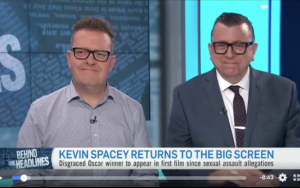 Writer Samantha Kemp-Jackson and social media star Stewart Reynolds join Richard and Beverly Thomson and CTV NewsChannel’s ‘Behind the Headlines’ panel. This week they take a closer look at Kevin Spacey’s return to the big screen following multiple allegations of sexual assault, Prince George playing with a gun and banning chocolate milk.
Writer Samantha Kemp-Jackson and social media star Stewart Reynolds join Richard and Beverly Thomson and CTV NewsChannel’s ‘Behind the Headlines’ panel. This week they take a closer look at Kevin Spacey’s return to the big screen following multiple allegations of sexual assault, Prince George playing with a gun and banning chocolate milk.
Watch the whole thing HERE!
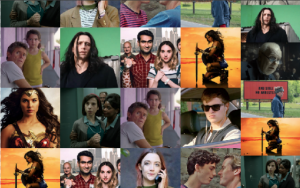 THE GOOD (in alphabetical order)
THE GOOD (in alphabetical order)
Baby Driver: Although it contains more music than most tuneful of movies “Baby Driver,” the new film from director Edgar Wright, isn’t a musical in the “West Side Story,” “Sound of Music” sense. Wallpapered with 35 rock ‘n roll songs on the soundtrack it’s a hard driving heist flick that can best be called an action musical.
The Big Sick: Even when “The Big Sick” is making jokes about terrorism and the “X-Files” it is all heart, a crowd-pleaser that still feels personal and intimate.
Call Me By Your Name: This is a movie of small details that speak to larger truths. Director Luca Guadagnino keeps the story simple relying on the minutiae to add depth and beauty to the story. The idyllic countryside, the quaint town, the music of the Psychedelic Furs and the languid pace of a long Italian summer combine to create the sensual backdrop against which the romance between the two blossoms. Guadagnino’s camera captures it all, avoiding the pitfalls of melodrama to present a story that is pure emotion. It feels real and raw, haunted by the ghosts of loves gone by.
Darkest Hour: This is a historical drama with all the trappings of “Masterpiece Theatre.” You can expect photography, costumes and period details are sumptuous. What you may not expect is the light-hearted tone of much of the goings on. While this isn’t “Carry On Churchill,” it has a lighter touch that might be expected. Gary Oldman, not an actor known for his comedic flourishes, embraces the sly humour. When Churchill becomes Prime Minister his wife, Clementine (Kristin Scott Thomas) makes an impassioned speech about the importance of the work he is about to take on. He raises a glass and, cutting through the emotion of the moment, says, “Here’s to not buggering it up!” It shows a side of Churchill not often revealed in wartime biopics.
The Disaster Artist: The key to pulling off “The Disaster Artist” is not recreating “The Room” beat for beat, although they do that, it’s actually about treating Wiseau as a person and not an object of fun. He’s an outrageous character and Franco commits to it 100%. From the marble-mouthed speech pattern that’s part Valley Girl and part Beaker from The Muppets to the wild clothes and stringy hair, he’s equal parts creepy and lovable but underneath his bravado are real human frailties. Depending on your point of view he’s either delusional or aspirational but in Franco’s hands he’s never also never less than memorable. It’s a broad, strange performance but it may also be one of the actor’s best.
Dunkirk: This is an intense movie but it is not an overly emotional one. The cumulative effect of the vivid images and sounds will stir the soul but despite great performances the movie doesn’t necessarily make you feel for one character or another. Instead its strength is in how it displays the overwhelming sense of scope of the Dunkirk mission. With 400,000 men on the ground with more in the air and at sea, the sheer scope of the operation overpowers individuality, turning the focus on the collective. Director Christopher Nolan’s sweeping camera takes it all in, epic and intimate moments alike.
The Florida Project: This is, hands down, one of the best films of the year. Low-budget and naturalistic, it packs more punch than any superhero. Director Sean Baker defies expectations. He’s made a film about kids for adults that finds joy in rocky places. What could have been a bleak experience or an earnest message movie is brought to vivid life by characters that feel real. It’s a story about poverty that neither celebrates or condemns its characters. Mooney’s exploits are entertaining and yet an air of jeopardy hangs heavy over every minute of the movie. Baker knows that Halley and Moonie’s well being hangs by a thread but he also understands they exist in the real world and never allows their story to fall into cliché.
Get Out: This is the weirdest and most original mainstream psychodrama to come along since “The Babadook.” The basic premise harkens back to the Sidney Poitier’s classic “Guess Who’s Coming to Dinner.” In that film parents, played by Spencer Tracy and Katharine Hepburn, have their attitudes challenged when their daughter introduces them to her African American fiancé. The uncomfortable situation of meeting in-laws for the first time is universal. It’s the added layers of paranoia and skewered white liberalism that propels the main character’s (Daniel Kaluuya) situation into full-fledged horror. In this setting he is the other, the stranger and as his anxiety grows the social commentary regarding attitudes about race in America grows sharper and more focussed.
Lady Bird: Greta Gerwig’s skilful handling of the story of Lady Bird’s busy senior year works not just because it’s unvarnished and honest in its look at becoming an adult but also, in a large degree, to Saoirse Ronan’s performance. I have long called her ‘Lil Meryl. She’s an actor of unusual depth, a young person (born in 1994) with an old soul. Lady Bird is almost crushed by the weight of uncertainty that greets her with every turn—will her parents divorce, will there be money for school, will Kyle be the boy of her dreams, will she ever make enough cash to repay her parents for her upbringing?—but Ronan keeps her nimble, sidestepping teen ennui with a complicated mix of snappy one liners, hard earned wisdom and a well of emotion. It’s tremendous, Academy Award worthy work.
The Post: Steven Spielberg film is a fist-pump-in-the-air look at the integrity and importance of a free press. It’s a little heavy-handed but these are heavy-handed times. Director Spielberg and stars Tom Hanks and Meryl Streep are entertainers first and foremost, and they do entertain here, but they also shine a light on a historical era whose reverberations are being felt today stronger than ever.
The Shape of Water: A dreamy slice of pure cinema. Director Guillermo del Toro uses the stark Cold War as a canvas to draw warm and vivid portraits of his characters. It’s a beautiful creature feature ripe with romance, thrills and, above all, empathy for everyone. This is the kind of movie that reminds us of why we fell in love with movies in the first place.
Three Billboards Outside Ebbing, Missouri: The story of a mother’s unconventional war with the world is simple enough, it’s the complexity of the characters that elevates the it to the level of great art.
Wonder Woman: Equal parts Amazon sword and sandal epic, mad scientist flick, war movie and rom com, it’s a crowd pleaser that places the popular character front and centre. As played by Gal Gadot, Diana is charismatic and kick ass, a superhero who is both truly super and heroic. Like Superman she is firmly on the side of good, not a tortured soul à la Batman. Naïve to the ways of the world, she runs headfirst into trouble. Whether she’s throwing a German tank across a battlefield, defying gravity to leap to the top of a bell tower, tolerating Trevor’s occasional mansplaining or deflecting bullets with her indestructible Bracelets of Submission, she proves in scene after scene to be both a formidable warrior and a genuine, profoundly empathic character.
“All the Money in the World,” a new true crime drama from director Ridley Scott, unwittingly became a talking point in the #MeToo conversation when disgraced star Kevin Spacey was disappeared from the film, replaced by Christopher Plummer. The ripped-from-the-headlines tale of ageing oil tycoon J. Paul Getty’s refusal to pay any ransom after his grandson’s kidnapping made headlines itself for the eleventh hour recasting. Question is, was the all the trouble worth it?
Set in 1975, the film begins with a pulse racing sequence that sees sixteen-year-old John Paul Getty III (Charlie Plummer, no relation to his co-star) plucked from the streets of Rome and thrown into a van by the Communist Red Brigade kidnapping gang lead by Cinquanta (Romain Duris). The family patriarch, tetchy tightwad J. Paul Getty (Christopher Plummer), denies the Calabrian mob’s demand for a $17 million ransom, in part because he suspects his grandson may have had a role in planning his own abduction and, more importantly, because he feels he’ll become an ATM machine (although they didn’t exist yet) for every kidnapper brave enough to scoop up one of his 14 grandkids. “My Gramps wasn’t just the richest man in the world,” explains Getty III, “he was the richest man in the history of the world.”
Months later the stakes are raised all round when Getty III’s severed ear shows up in the mail. As former CIA agent Fletcher Chase (Mark Wahlberg) investigates—“Bring him back as quickly and inexpensively as you can,” he is told.—the young Getty’s mother, Gail Harris (Michelle Williams) appeals to Getty senior’s better nature.
Based on the book “Painfully Rich: The Outrageous Fortunes and Misfortunes of the Heirs of J. Paul Getty” by John Pearson, “All the Money in the World” is a handsomely made, if not terribly deep, thriller. Scott can stage an action scene and build tension but the real star here is Plummer. As “the old one with the money” he hands in the second example this year after “the Man Who Invented Christmas” as to why he was perhaps born to play Ebenezer Scrooge. The sensational aspect of the casting aside, he hands in a performance that is one part doddering grandpa, one part cold-blooded shark. When he says, “There’s very little in life worth paying full price for,” in reference to his grandson it sounds like something your grandfather might have said. When he refuses to pay the ransom until he realizes it could be a tax deduction, it sends a chill down the spine.
Wahlberg doesn’t fare as well. He may be the film’s biggest star but he’s miscast as the calculating ex-CIA agent. Williams is better, all compassion and determination.
By the end credits it’s obvious that “All the Money in the World” isn’t simply a real life crime story but a timely gaze into the lives of the super rich. “We look like you,” says Getty III, “but we are not like you.”
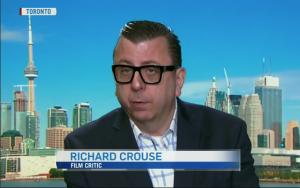 Richard comments on Kevin Spacey’s response to allegations of having sexually assaulted an underage man.
Richard comments on Kevin Spacey’s response to allegations of having sexually assaulted an underage man.
Watch the whole thing HERE!
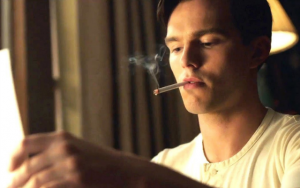 By Richard Crouse – Metro In Focus
By Richard Crouse – Metro In Focus
There’s a meme that occasionally pops up on my social media pages. It’s a picture of a person slumped over a typewriter, fists clenched, captioned with the words, “Writing is easy. You just sit at your typewriter until little drops of blood appear on your forehead.”
Anyone who has tried to put words on a page will understand the joke. Writing at a high level requires a combination of talent, study, life experience and dedication; a folio of concrete and ephemeral elements that can blend easily or remain frustratingly difficult to access, depending on the day.
The story of James Joyce’s exasperation while writing his modernist novel Ulysses perfectly illuminates the writer’s frustrating process. As the story goes, a friend dropped by Joyce’s home to find the author upset that after a full day of work he had only written seven words.
“Seven?” his friend says. “But James that’s good — for you, at least.”
“Yes,” Joyce says. “I suppose it is. I’m just not sure what order they go in!”
It should come as no surprise that writers love to write about writing. Screenwriters have tapped out thousands of pages in an effort to illuminate the mysterious process.
From biopics like The End of the Tour and Capote to dramas like Adaptation and Misery, movie after movie has focused on the various ways words make it to the page in the right order.
This weekend Rebel in the Rye is a glossy look at author J.D. Salinger’s unlikely journey from losing a girlfriend to Charlie Chaplin, to the Second World War, from eastern religion to writing the classic novel Catcher in the Rye.
Movies about writers often feature scenes of typewriters clacking, pages crumpled and thrown in the garbage as authors attempt to whip their manuscripts into something readable. Crumpled loose-leaf is a tangible sign of the work, but does little to explain the author’s thought process.
The movie Genius, starring Jude Law as author Thomas Wolfe, does a good job of showing the very lifeblood that flowed through his veins. The You Can’t Go Home Again author creates exciting wordplay that could be compared to the free-flowing fluidity of jazz.
To illustrate the difference between his work and the more staid style of his contemporary Henry James, he pays a jazz band to play a straightforward, traditional version of Flow Gently, Sweet Afton.
“That’s Henry James,” he says as the players plod along. But as the band heats up, splintering off into melodic tangents, he grins and says, describing himself, “That’s Thomas Wolfe.”
The process by which artists go about their work is near impossible to effectively capture on film, but this scene comes close to explaining what it feels like when the creative juices are racing.
Subtler is Paterson, a gentle look at the life of a poetry-writing Paterson, N.J., bus driver played by Adam Driver.
The poems aren’t for publication, simply a way to express his joy in the beauty and art of everyday life. When his dog eats his notebook he has to start again but learns the writer’s greatest lesson.
“Sometimes the empty page presents the most possibilities.” There is great uplift in those words. The blank page isn’t a hindrance to the work but a canvas on which to create something new. It’s the simplest and most beautiful expression of how art is made I’ve ever seen in a movie.